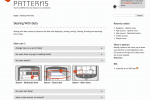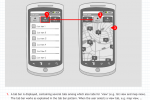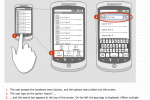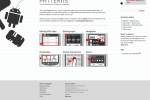This page is also available in dutch
We have been working on it for a while, and it will be ‘work in progress’ for a while longer, but it does deserve a blog post by now: our Interaction Pattern Library for Android on androidpatterns.com. Designers and developers have already noticed the website. We are receiving over 40,000 visitors monthly from 137 countries and that number is steadily growing. Why did we start this project? And what can the world do with it? A short history…
Interaction designers and pattern libraries
Pattern libraries are websites with collections of interaction patterns, which we, as interaction designers, often use in our daily design practices. They show how certain design problems can be solved using examples. Commonly used libraries are Yahoo, Welie, UI-patterns, Patternry and Pattern Tap. These are made for web, and are not very applicable to mobile devices.
Apple’s guidelines and Google’s source code
Designers for iPhone or iPad applications can turn to Apple’s iOS design guidelines. These will give a detailed description on how to properly use the Apple User Interface elements. It is not a pattern library, like the examples mentioned earlier, but it is a very useful document in which Apple explains how to use certain elements. It is extensive and detailed. It will give you all information needed to design for iPhone and iPad, and studying these guidelines is essential if you’re designing for this platform.
Apple’s competitor Google takes a different approach with their open source Android OS. On the Android developers site developers of software and hardware can find the necessary tools, documents and source code with which they can get started. In the source code all elements created by Google’s developers, are defined. The code can be used and adapted by developers themselves. There are no rules before or after. Applications don’t need to be approved, they way they do at Apple’s App Store. The result is that applications on Android devices can look and interact very differently.
There are UI guidelines on the Android developers site that can help designers, but they only deal with the basics of Android, for example how various menus work. All other elements are only discussed in terms of code. Not something of much use for us interaction designers.
A pattern library is born
We started to bump into questions like: “How does that work on Android?”, “Is this a common solution?” and “Can I solve this differently?”. When designing for web we can find these answers in existing pattern libraries. But for mobile applications, we couldn’t find anything online yet. Because of the lack of tools for interaction design for Android applications, the idea was born to create a pattern library ourselves. We registered the URL, made a plan for the library with a group of Android users at UNITiD, and made a plan to get started.
Wireframes at the basis
During the months that followed we took hundreds of screenshots from which we gathered the patterns. Only when proven to work more then once, we regarded a interaction design solution to be a real pattern. The basic principle of this pattern library is that it should help designers like us. This is why we approach patterns from questions we could run into during the design process. These questions have been grouped in categories and the answers on these questions each led to a pattern.
As interaction designers we are used to tell our story using wireframes. A good method to also explain how the Android patterns work, we thought. Every pattern page opens with a wireframe which explains how it works. Then we talk about its context: when to use the pattern, when not to use it, and which other patterns could be considered in the same situation. We have also added The Good and The Bad of every pattern, to conclude with examples of the patterns being used in various applications.
Participate?
It would of course be great if this pattern library, just like the libraries mentioned before, will continue to draw a steady and growing amount of visitors. Until now 50 patterns have been published, divided over 6 categories, and we have collected many more that will be added to the website soon. And as Android is continually developing, including an OS for tablets, we will have plenty of work cut out for us!
Did you also discover a pattern that you would like to share with us? On Android Patterns you can read how to do this. Of course, you will receive all the credits and a link to your own website.











